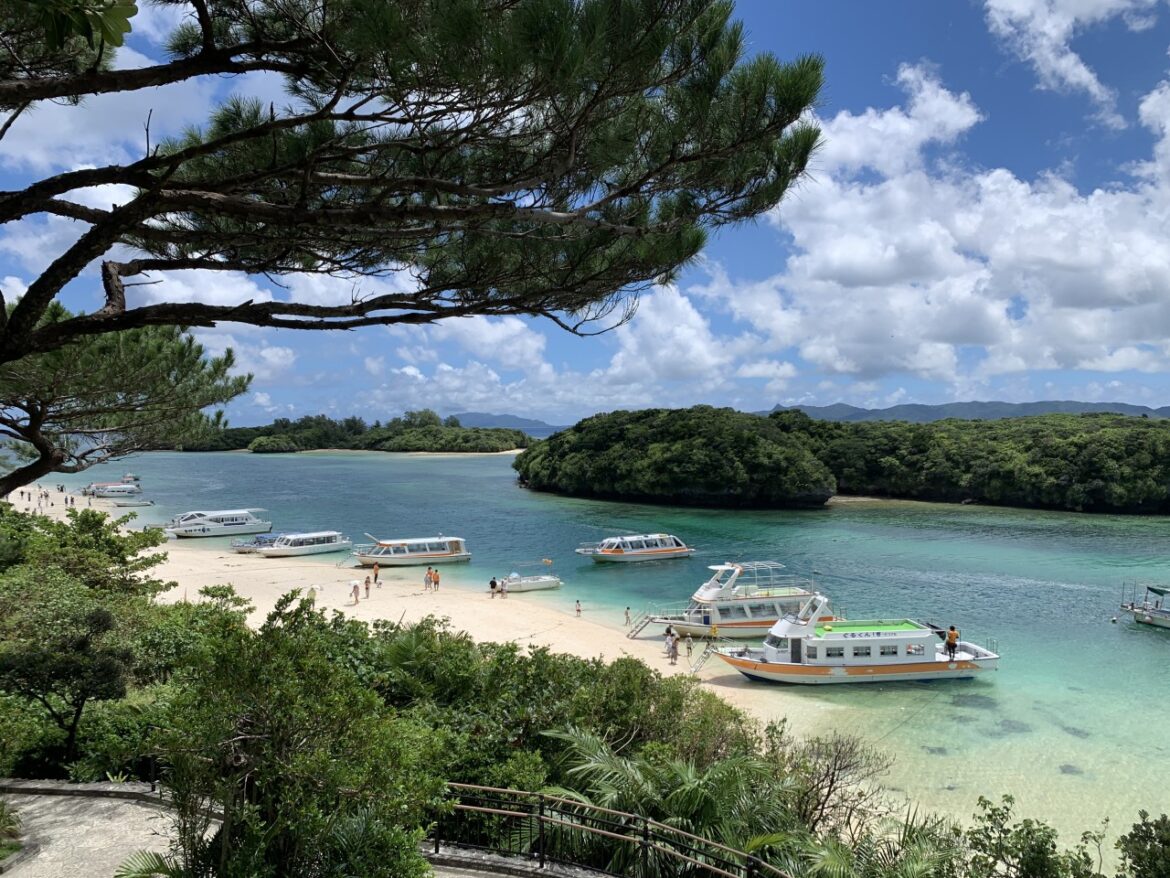One of our newest writers Evie shares her experiences exploring and enjoying the stunning beaches of Ishigaki after flying in from Tokyo.
Life moves slower here
That’s one of the first things I heard on the sub-tropical island of Ishigaki, home to some of the best Okinawa beaches, and located closer to Taiwan than mainland Japan – but Japan all the same.
Like everywhere else in Japan, the island still runs on a steady stream of Family Marts, bowing, and most importantly, omiyage. So much omiyage: little pastry boats filled with purple sweet potato cream, dense brown sugar donuts, salted milk sandwiches, dark lumps of hibiscus flavoured sugar and… snake awamori, a kind of liquor where a whole habu snake is left to marinate inside the bottle. I’ve been told it has a particularly high alcohol content – presumably to help you deal with the fact you’re drinking it.
There are also the shisa: cute, brightly coloured lion-dog creatures, one boasting a big toothy grin to ward off evil and another with its mouth closed to keep in the peace. You’ll see these traditional Okinawan figures, a legacy of Chinese influence from the 14th century, outside of the gift shops, sitting proudly in locals’ gardens or standing as big stone statues decorating the streets.
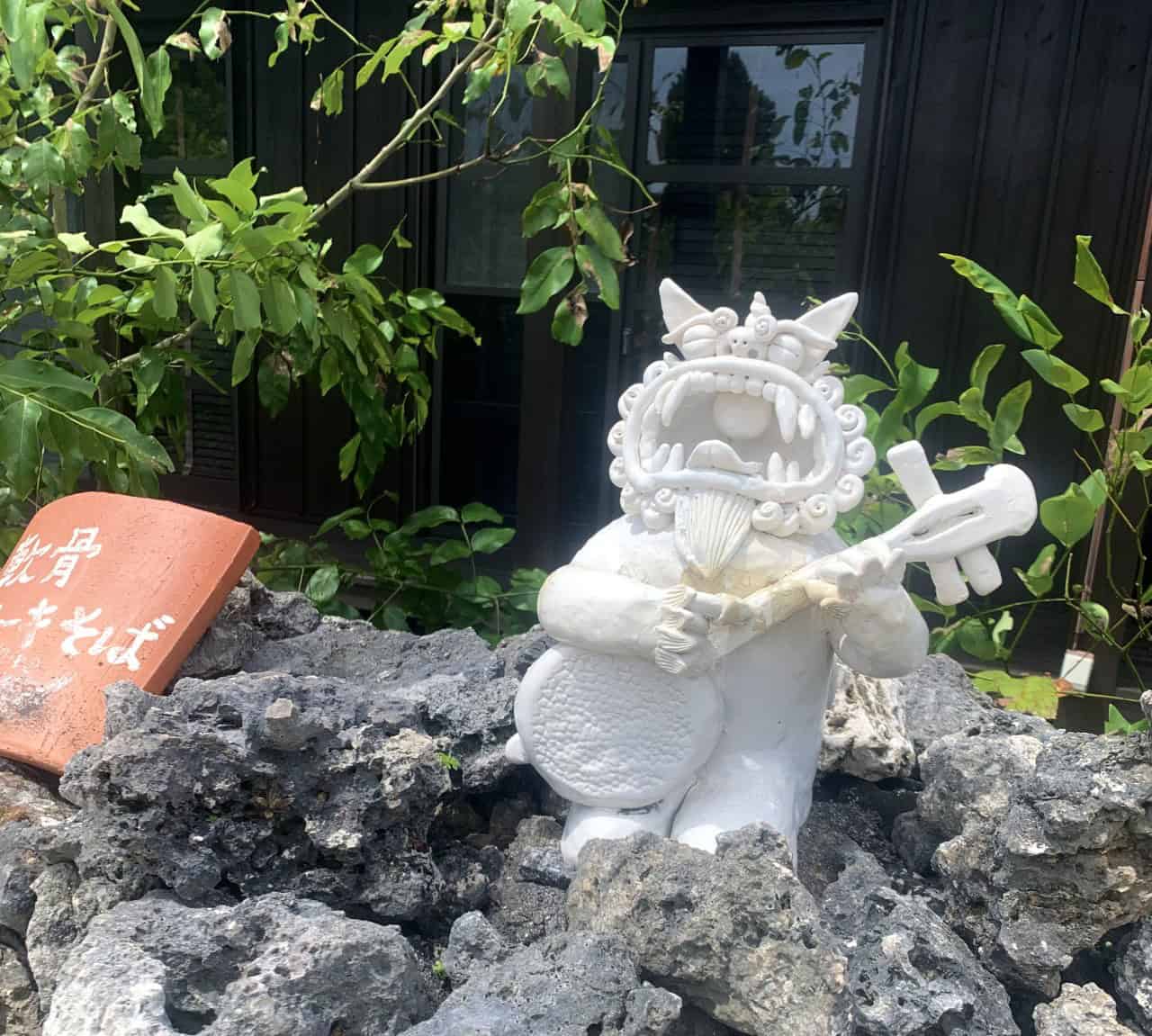
Coming from Tokyo, especially, Ishigaki felt like a whole other world, and in some ways, it is. Part of the Yaeyama islands, Ishigaki’s history has run parallel to, rather than with, the mainland’s: up until the late 19th century, it was a small piece of the Ryukyu Kingdom, an independent realm made up of elements of Japanese, Chinese, and Southeast Asian cultures. The islands even have their own dialect, Yaeyama – although not many speak it anymore.
As I left the airport, Ishigaki was already the least busy tourist destination I’d visited in Japan. The bus from the airport was almost empty, apart from a family and a few suitcases. Outside was the same: vast patches of farmland and forests that gradually transitioned into concrete buildings and traditional houses with scalloped apricot rooves. Tokyo’s huge, musical billboards and high rises were miles away – thank God.
I arrived at the hostel at around 5pm – a modern square swarming with digital nomads and families regretting their attempts to save a bit of money.
Could we check your passport please?
I dug into my enormous backpack, muttering sumimasen while piling a precarious tower of things onto a nearby table: five books (who was I kidding?), a pack of sake flavoured KitKats, two pens, an old clump of receipts, a bag of coffee and – oh no, no passport.
I checked my bag again. No passport – a problem in Japan, where every foreigner must always carry ID. I called the airport, on the off chance that I had maybe dropped it somewhere. They didn’t have it either. I handed over my residence card with my fingers crossed.
Ok, you’re checked in! We’ll call the airport for you again later. I sighed in relief.
So, hungry, tired, and trying not to imagine myself getting deported, I went out in search of food.
A City that Feels like a Town
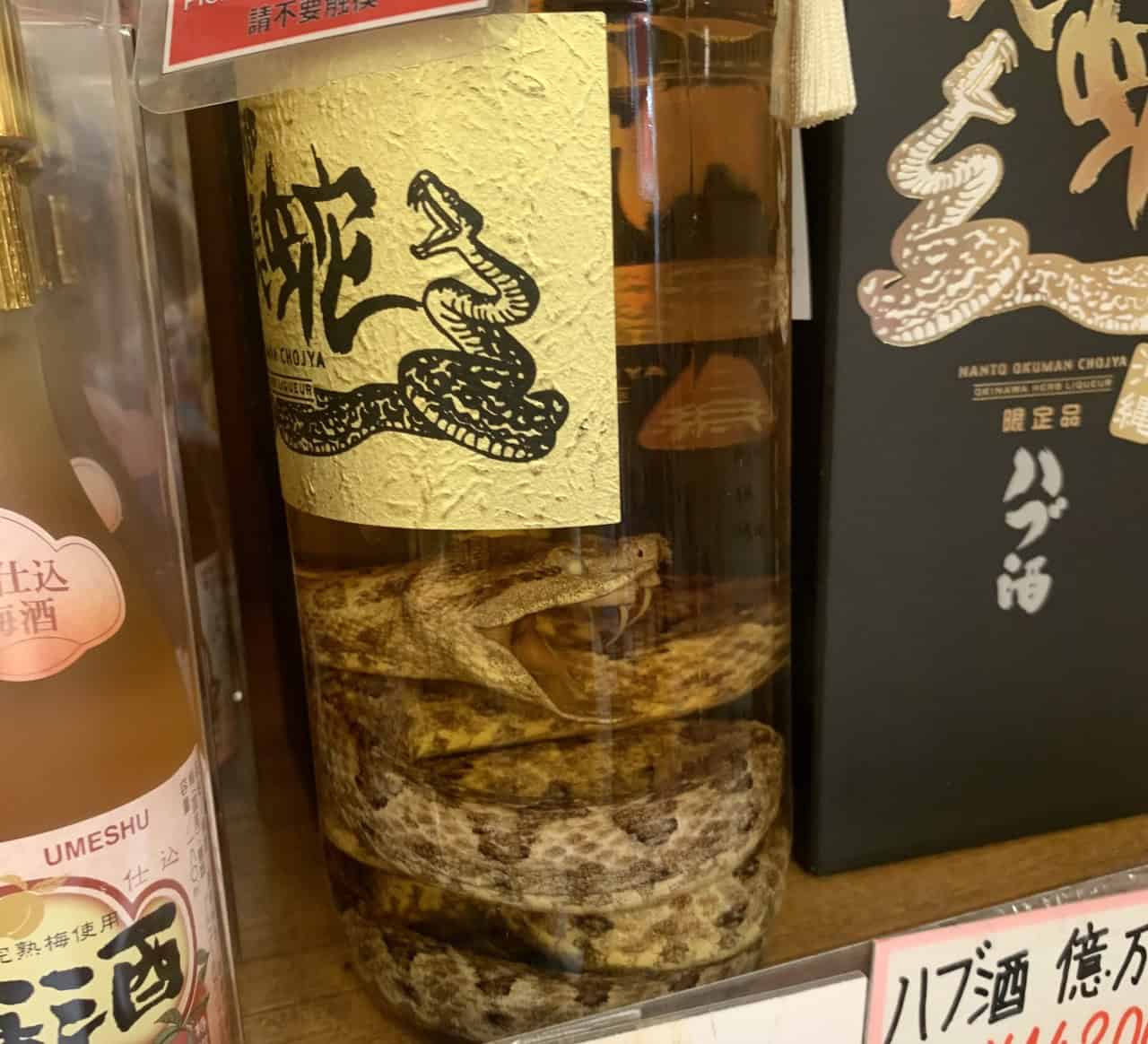
A few years ago, I read Mandeville’s Travels for university, one of the earliest travelogues, written around 1350. In it, Mandeville, a so-called knight, journeys from Europe to Asia in search of knowledge and enlightenment – the original gap year? One part always stuck with me, though: Mandeville tells of a traveller who went so far east that they began to hear their own language again; suggesting that even far into the unknown, there’s familiarity to be found.
In the same vein, sometimes you travel to a remote island on the other side of the world and find a Scottish guy flogging deep-fried mars bars from a chip van.
Life moves slower here – that’s why I like it. I was seated at a metal table and chairs outside – a luxury for a Tokyoite – listening to Scottish Guy explain how he ended up running a fish and chip van in Okinawa. Around ten years ago, he was hired to open some restaurants in Hokkaido, and things snowballed from there. Soon enough, he married a local and settled down in the slowest place in Japan. So slow, apparently, that Scottish Guy managed to sleep through multiple tsunami warnings that, thankfully, turned out to be only 10cm high.
I explained my passport situation to him and the young Japanese family sitting next to me, neither of whom seemed particularly moved. You don’t need a passport here, it’ll be fine!
I asked if I needed one for the ferry. Probably not. Don’t worry about it, he said, handing me a bright blue bottle of gin with OKINAWA printed on the label, and a bottle of malt vinegar. You know what to do with that.
…
I was woken up the next morning by a tiny lizard darting across my hostel door. It was my birthday, and I was going to spend it floating in the sea. The closest (non-manmade) beach to Ishigaki port, where most of the cheaper accommodations are located, is called Maesato beach – about a 20-minute cycle, or a 10-minute bus ride if you want to brave the sparse timetables. Luckily, my hostel rented out bikes – albeit very small, slightly comical looking bikes – to explore the island at will.
Ishigaki didn’t feel like a city. It reminded me a bit of those half-empty American towns you see in road trip movies, a strange oscillation between palm-lined resort and traditional Japanese bungalows framed by bonsai trees and stone shisa. It’s a tourist destination, but it doesn’t shout about it. There is no long strip of high-rise resorts and tourist traps. There are no neon lights or flashy rooftop bars. Instead, there’s the sea, the sky, and an unassuming city centre of small industrial buildings and residential areas, broken up by the occasional Hawaiian-themed café or artisan coffee roaster.
I wasn’t really expecting much from a beach whose most positive reviews were along the lines of ‘not spectacular, not bad’, but Maesato beach was beautiful, and much better than the second nearest Fusaki beach, whose murky water was overrun by clumps of seaweed and screaming children. Once you navigate past the confusing ‘visitors entrance’ of the hotel attached, you’ll find a path lined by tangled palm trees and pineapples ready to drop, ending in bright blue water and white sand. Like many of the swimmable beaches in Ishigaki, Maesato has a netted area to fence off the lethal box jellyfish that return every summer. It’s tempting to find a more secluded area, but best not to risk it.
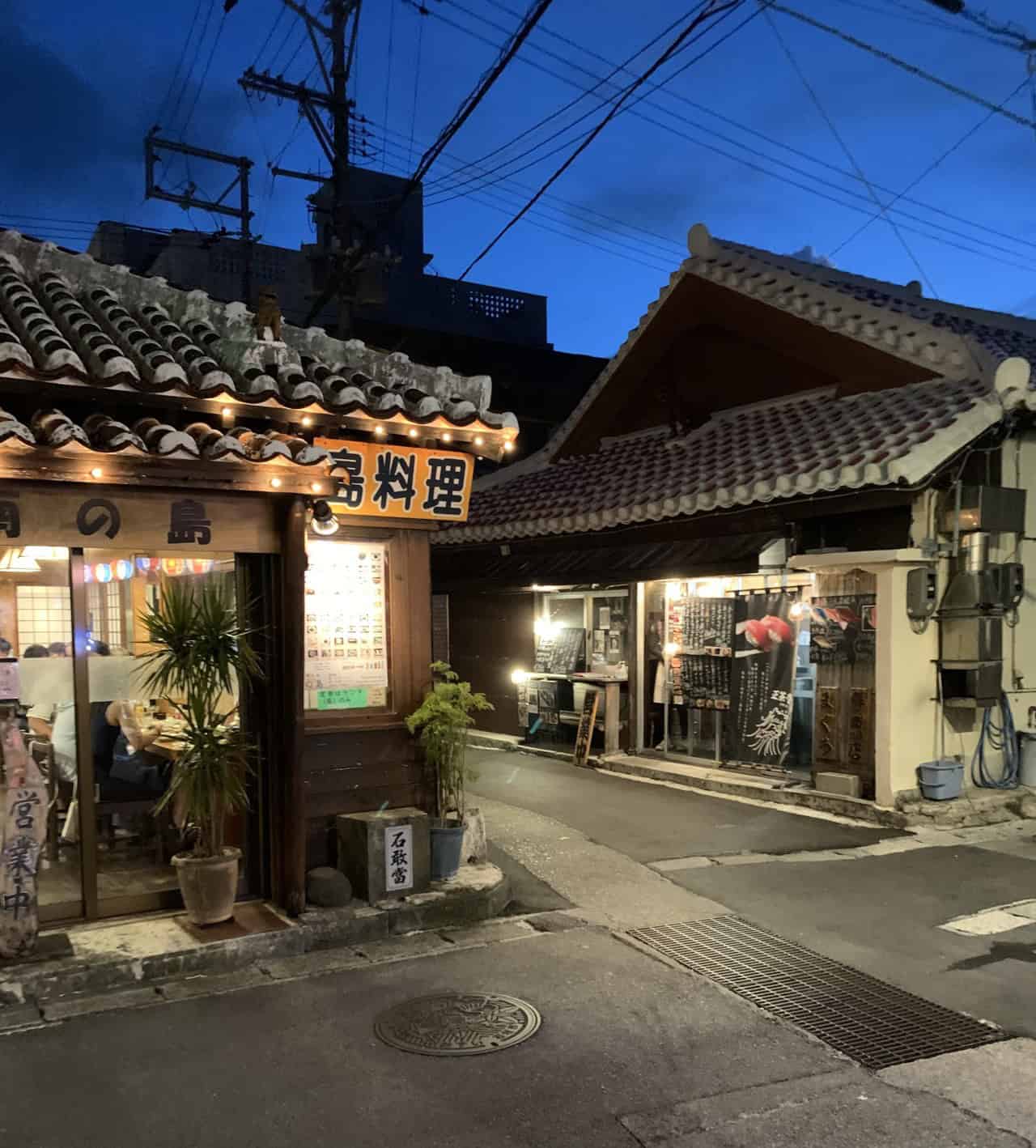
In the evening, I was recommended an outdoor izakaya in the city centre serving lots of Okinawan specialties, not Mars Bars. I ordered the sea grapes, clusters of seaweed resembling tiny grapes that burst with sea salt, purple sweet potato mochi – a moreish hybrid of chewy mochi and earthy sweet potato fries with mayo on the side – and goya champuru, a stir fry dish with tofu, egg, and frilly slices of bitter melon. They also serve special Okinawan sours, infused with shikuwasa, a citrus fruit that looks and tastes a bit like a miniature lime, found scattered on the floor pretty much anywhere you go.
After singing Karaoke into the AM with a lovely old Japanese lady and a prostrate cockroach, I woke the next day to catch the first ferry to Taketomi island.
Taketomi and Iriomote Islands
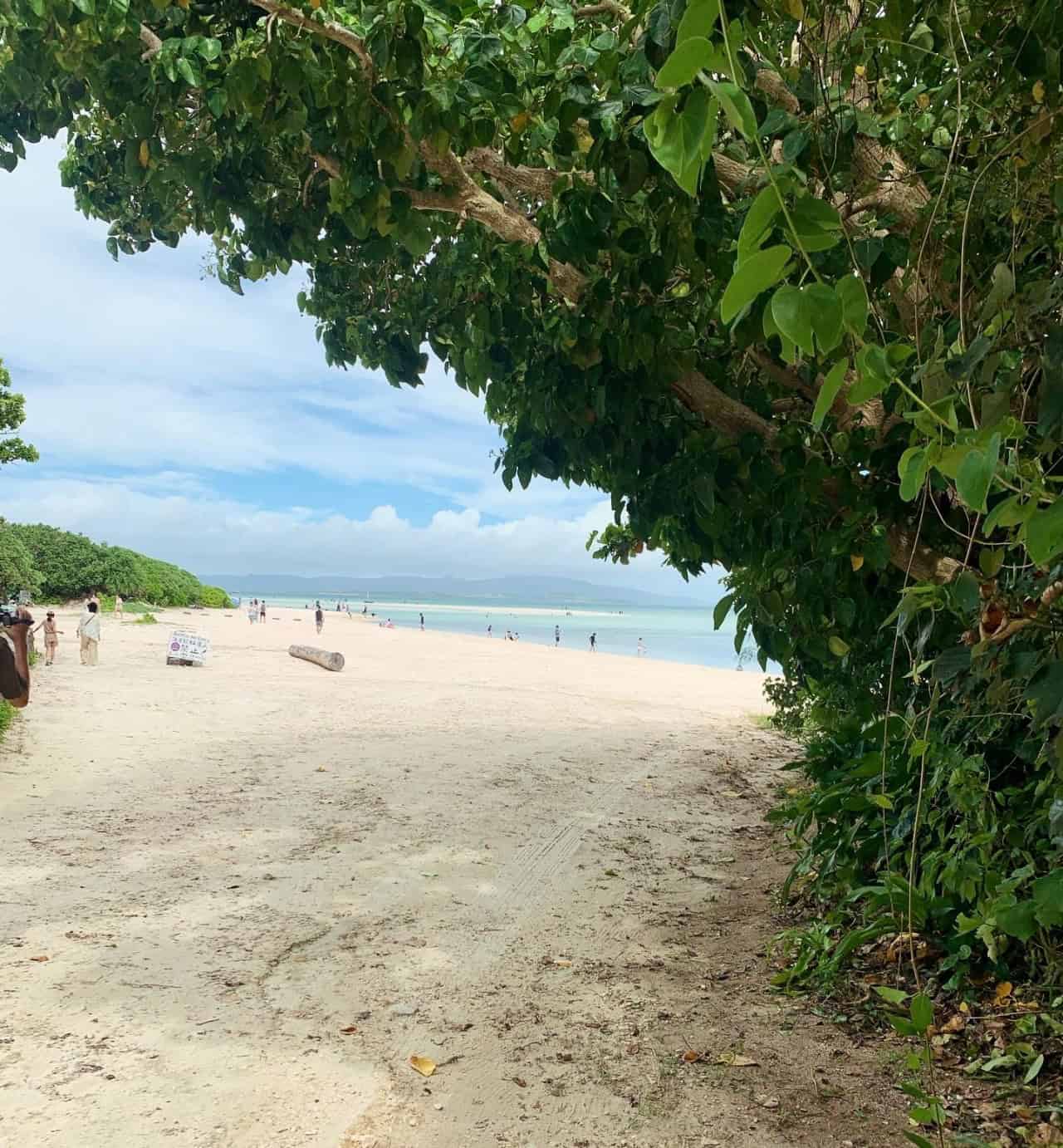
Turns out, Scottish Guy was right: you don’t need a passport to take the ferry. This was good news, since Taketomi has some of the most idyllic beaches in Yaeyama. Taketomi is famous for two things: water buffalo rides through the island’s old Japanese village, and star-shaped sand – supposedly. I, honestly, couldn’t find any, discounting the bottle of it I bought from a street seller for 200 yen. But that’s ok, because that’s not why Taketomi is worth visiting.
The small village is charming and lowkey, with a few very good restaurants serving traditional Okinawan fare. Most importantly, the beaches are picture perfect. The shallow water at Kondoi beach is so clear that it barely feels natural, and the soft white sand coils into the sea like a nautilus shell – giving you a nice spot to wade to and take photos. Even the cloudy weather didn’t spoil the view.
After a few hours, I walked to Kaji beach, which I’m sure does have star-shaped sand if, unlike me, you have the mental endurance to search for it in the 35-degree heat. I, however, was content to dip into the sea, remember jellyfish exist, then pass out under some palm trees for two hours. Island time, island time.
…
The next day trip was to Iriomote island, a UNESCO world heritage site and the second largest island in Okinawa prefecture. Exiting the port, you’re greeted by a sign reminding you that 90% of the island is covered by dense jungle and mangrove swamps – not somewhere you’ll find an old lady with a karaoke jukebox – but this is Japan, so anything is possible.
My time on Iriomote was limited: while getting around Ishigaki without a car is easy enough if you plan it right, Iriomote is very different. It’s almost impossible to do anything here unless you rent a car or book a tour, which is what I did. I was picked up at 9am by a woman who can only be described as frantic. I didn’t mind the chaos though; I needed the extra time to try and squeeze myself into the size 5 water shoes I’d been given – the largest women’s size they had.
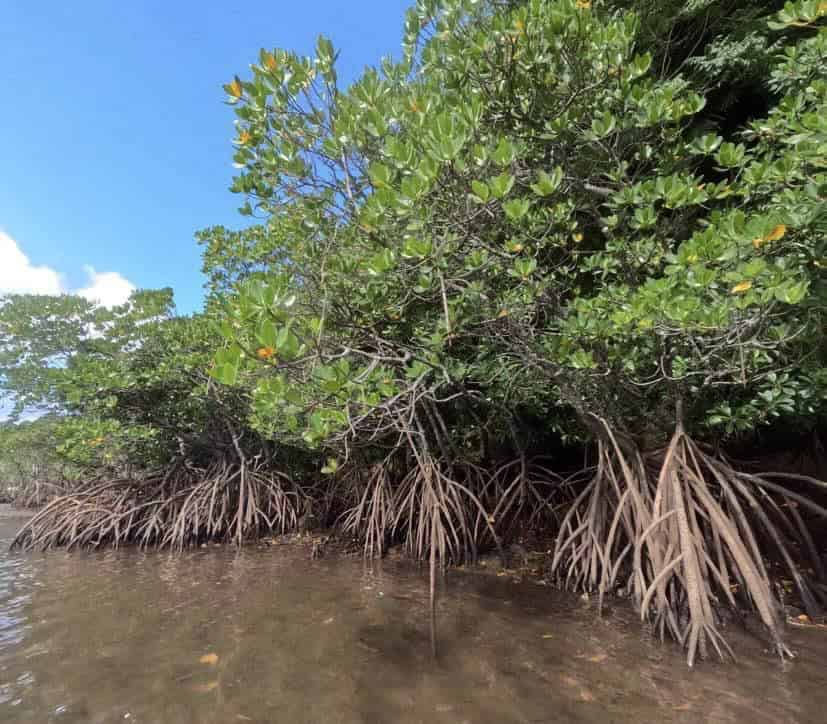
After a short drive, we walked down to the Urauchi river, the longest in Okinawa and closest to the main port. Urauchi river flows through a dense mangrove forest, where trees grow underwater and emerge out of the river in spidery knots. They need very specific conditions to thrive, and Iriomote’s mangrove forests account for about 70% of Japan’s entire population. After kayaking down the river for a while, we stopped at the edges of the forest to catch our breath and admire the landscape.
I don’t think I’d ever been somewhere so full of life before. As the type of person who was still anxious about my misplaced passport, I usually like to keep my distance from insects. Lucky for me, these guys weren’t used to human company; the slightest movement sent the entire ground rippling outward – a refreshing change from having to run away myself. There were so many creatures blending into the forest that the floor itself was a green sea, shifting and expanding with every step.
There were little bug-fish hybrids that glided along rocks, beetles that I wanted nothing to do with, and small, spindly crabs that disappeared into the sand in less than a second. My tour guide scooped up the damp sand and big, bulbous brown bodies with thin legs overflowed from her hands. Would you like to hold them? She asked, gesturing at the ground. Absolutely not, I said, mesmerised.
Finding Nemo – and Sea Snakes
OK, forgive me, but I’m ambivalent, at best, towards snorkelling. I know it’s beautiful and like nothing you’ve ever seen – a whole other world – but to me, nothing sounds worse than strapping a sting-tight pair of goggles to my face and avoiding contact with hundreds of unidentifiable creatures. It didn’t take much to dissuade me after reading about the venomous habu snakes that live in Okinawa’s waters. Maybe habu awamori isn’t so bad, after all.
For those with more gumption, though, I’ve been told that Ishigaki has some of the best areas for snorkelling in Okinawa. You can find a tour, or simply pick up some basic gear from the huge Don Quijote near Maesato beach and catch a bus to Ishigaki’s sacred Blue Cave, teeming with brightly coloured fish.
Lucky for me, Kabira Bay, arguably Ishigaki’s most iconic landmark, offers glass-bottom boat tours for around 1000 yen: all the otherworldly beauty without any of the ‘what just touched my leg?!’ panic. The driver takes you around all the best areas of Kabira Bay’s technicolour coral reefs, where you’ll spot turtles, schools of colourful fish and of course, Nemo. Nearby is a little restaurant serving traditional Yaeyama soba, a concoction of thick udon noodles in a light broth and strips of pork ribs. Don’t forget the green Ishigaki pepper salt, which you’ll find on every restaurant table.
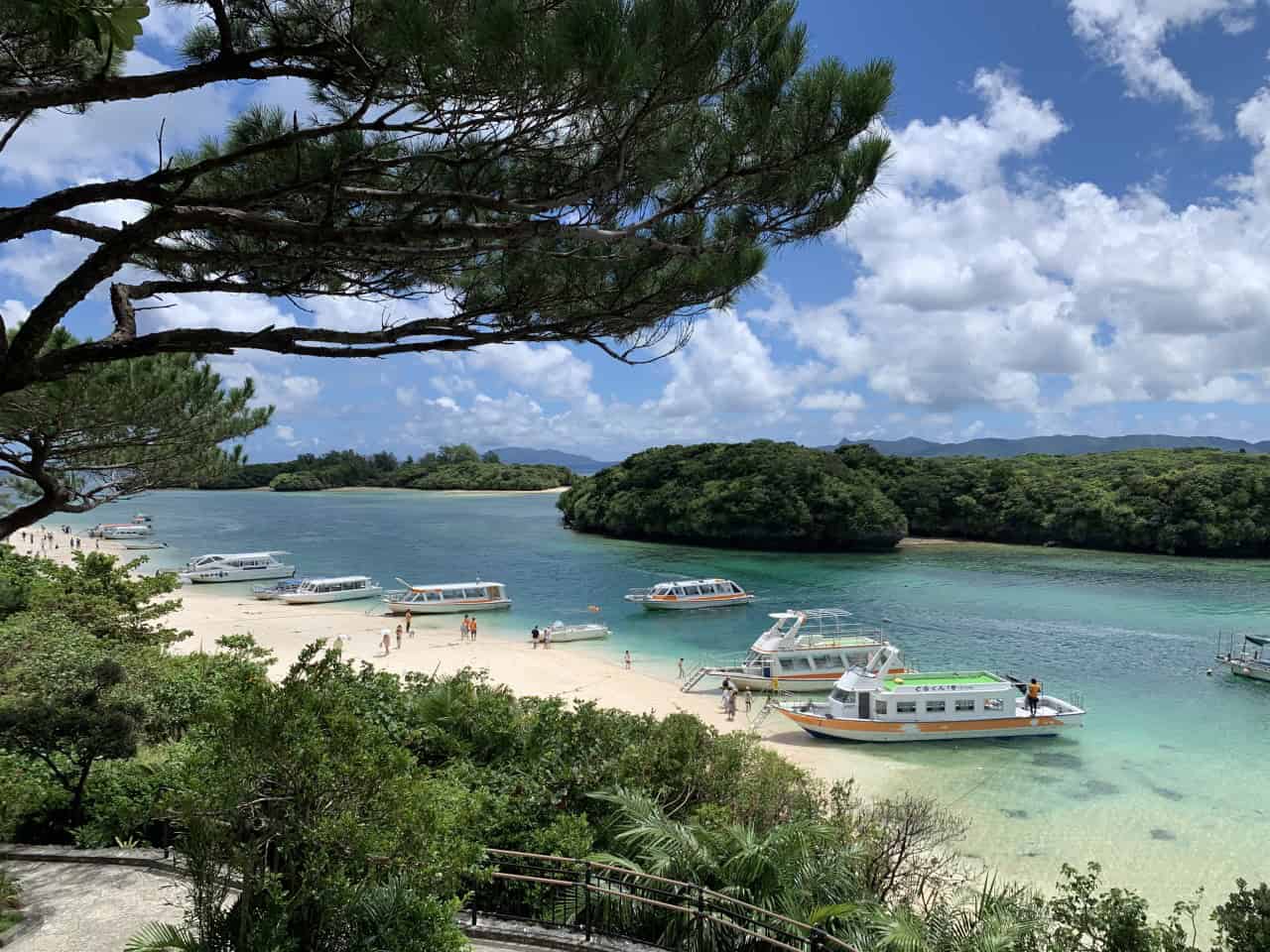
After the boat ride, I walked half an hour to the nearest beach, Sukuji. This was one of my favourite beaches of the trip, partly because of the walk there, which wound through farmland and thick patches of jungle with the faint, sickly sweet scent of rotten fruit hanging in the air.
Sukuji’s coastline is incredibly quiet, with a section cordoned off for swimming. Approaching the entrance, framed by palm trees and lime-green foliage, for the first time, I had the same feeling I get when I come across an abandoned shrine in the woods: like I’d stumbled upon some half-whispered secret. Swapping the scent of rotten mango for the salt of the sea, I stayed the rest of the day – passport out of mind.
I returned on the last bus, a towel wrapped around my shoulders, damp and slightly bedraggled from my hour-long walk in the sun. I looked like I’d been washed ashore. Still, nobody stared – a rarity as a foreigner.
Okinawa Beach Island Time
On my last day, I woke up at 5am to embark on a tofu pilgrimage. I kept hearing about a restaurant called Tofu Higa, specialising in yushi-dofu, a kind of fluffy, half cooked tofu made fresh and served in a broth with soy sauce. The only issue? They reliably sell out by around 8.30am. So, too early to rent a bike, I stumbled out of my hostel on 4 hours sleep and began my 40-minute walk to Ishigaki’s surrounding farmland, an empty landscape of huge green palms bent from their own weight and fields of sugar cane divided by brown streams.
Even at 7am, there was a queue. I ordered the omelette set, which even came with a small glass of soy milk on the side. The portion sizes here, despite the low price, are huge. The journey was well worth it, even if just for the scenery and the quiet; I have to say that by the end, though, I was a little soy-ed out.
Still half-asleep after eating my body weight in tofu, the walk back felt a bit like waking from a dream. I immediately passed out in my bed and woke again at 1pm, questioning whether I’d ever left at all.
…
After coming to terms with the fact I had woken up only to eat breakfast and then go back to sleep again, I grabbed a brown sugar latte and took the last bus back to Maesato beach.
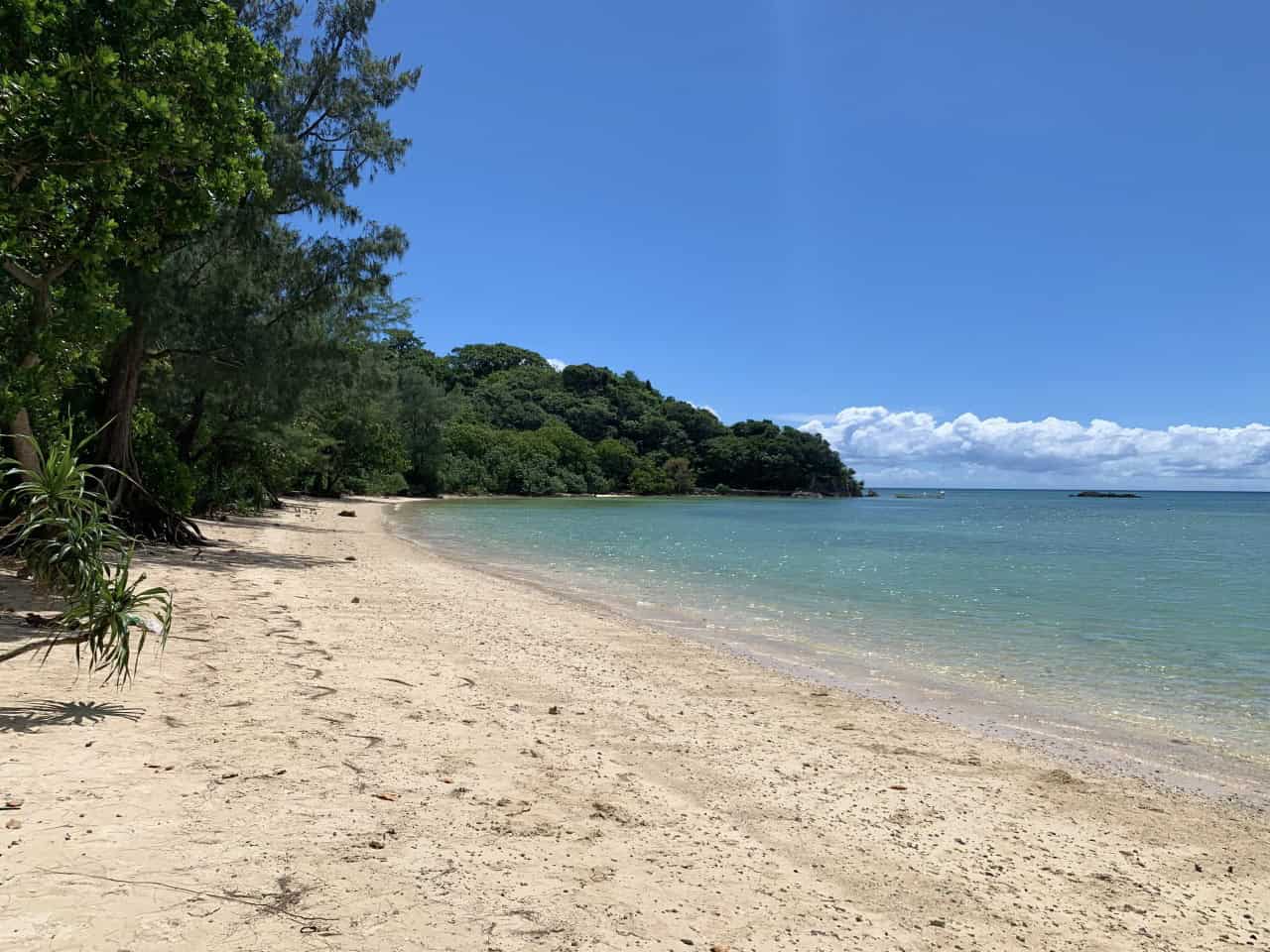
Laid on a hotel lounger, I watched as families played in the sea, despite a sign banning swimming after 6pm. Still, the beach was emptying and giving way to tiny red crabs – so small I thought at first they were bugs – crawling towards the shore in a hidden world of sand dunes and giants. One had a patch of moss on its shell and held up one claw as if repeatedly excusing itself. I moved my bags out of its way and watched as the sky purpled with dusk. Time stretched and softened. The hotel staff had packed up most of the loungers, but there were still families in the sea, oblivious, or maybe ignorant, to the rules.
The next day, I returned home to find, lying on the bed, my passport.
Direct flights to Ishigaki from Tokyo take about 3 hours and a half, and then from Ishigaki Airport to the city centre, the bus ride is 30 to 40 minutes and costs about 500 yen. You can find more info on Getting to Ishigaki and the Yaeyamas here and from Ishigaki Airport to Ishigaki Bus Terminal (city centre) here .
We hope you found Evie’s account of Ishigaki helpful, and if you’re looking for more Japan travel inspiration or Japan travel guides, please check through our travel section. For those traveling to Japan soon, we’d recommend subscribing to our Japan Travel newsletter using the widget below to get more travel tips and discounts for your upcoming trip.

